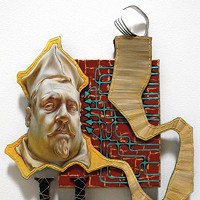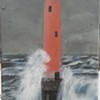When one discovers every painting has a unique story to it, art becomes less obtuse. Knowing this can demystify complex movements like cubism and conceptualism and bring new meaning to seemingly dull landscapes, portraits and history paintings. Such an understanding is important when it comes to The Weir Family, 1820-1920: Expanding the Traditions of American Art, a traveling exhibition that shares a uniquely American story of 19th century painting.
The Weir Family, currently at the Mint Museum Uptown, illustrates American art history and its important developments, as affected and inspired by European tradition. Chronologically organized, the show begins with depictions of military generals, unspoiled American landscapes and traditional renderings of events, and then slowly moves toward flat impressionistic styles of the late 19th and early 20th centuries. The exhibition covers this time span with selections from the oeuvres of three members of the Weir family: the patriarch, Robert, and two of his 16 children, Julian Alden Weir and John Ferguson Weir.
Robert Weir was one of the first Americans to study history painting in Rome. A standard practice for any European painter, the idea of sketching and observing antiquities was lost on Americans, who rarely had the space or desire for large-scale depictions of Biblical and classical tales. In merging these two styles, Weir produced works with American figures and American opinions (Protestantism, freedom, historical narratives) inserted into European style paintings. Upon Weir's return to the U.S., President Andrew Jackson appointed him to West Point as an art instructor; there, he taught skills needed for cartography and field studies. All of his 16 children were born there, including the two sons who would also gain fame as artists.
Weir's true skill as a painter is on display in one of the exhibition's hallmark works, a facsimile of his piece "The Embarkation of the Pilgrims." The original is located in the rotunda of the U.S. Capitol in Washington, D.C.; Weir won the opportunity to paint this scene through a competition. The pilgrims are depicted in the history-painting style popular in Europe at the time: emotive and well composed amongst objects specific to the story.
Weir's first son, John, became a notable painter in his own right. He tended toward an affinity for the old master style and followed in his father's footsteps with a stint in Rome studying the ruins and the Renaissance. Arguably a less prolific painter than his brother Julian, John Weir heavily influenced the study of art in America by establishing the first university art program at Yale University in 1869. He directed the program there for 44 years.
John Weir had access to how an art institution should run through his brother Julian, who studied at the École des Beaux-Arts in Paris for four years. Julian Weir is a notable Impressionist with works in most major American museums. He began his studies at the École in 1873 under the respected classicist Jean-Léon Gérôme, and soon after encountered the impressionist style for the first time at a salon. "It was worse than a Chamber of Horrors," he wrote in a letter home, although he soon adopted the style for his own painting. Heavily influenced by an 1881 show of Edouard Manet's work, Julian Weir could not prevent Manet's signature flatness from seeping into his own work. His painting "Flora" is a prime example: The viewer is given no indication of space between the model (Julian and John's sister Carrie) and the background, and the black table holding a bouquet is barely rendered with any dimensionality. Thick impastoed white flowers match the lace of the model's dress; fabric draped around her body echoes in the sweep of her hair.
While these paintings are lovely to look at, the audience is reminded that Americans began making important strides in providing the world with original art in the 20th century. However, the legacy of the Weir family and its documentation of American life and events of the time is something we should hold sacred as a part of our own history. Their contributions to the study of art in America deserve to be honored in this way.
The exhibit The Weir Family, 1820-1920: Expanding the Traditions of American Art will be on display through Jan. 20, 2013, at the Mint Museum Uptown, 500 S. Tryon St. Details: (704) 337-2000 or www.mintmuseum.org.
Speaking of...
-

New Documentary Will Showcase Untold Story of Melungeon People
Jul 18, 2018 -

Remember When We Scorned Royalty?
May 16, 2018 -

Jay Robert Watson Brings Urban Landscapes to Life
Feb 28, 2018 - More »
Latest in Visual Arts
More by Grace Cote
-

Jason Watson's narrative potential
Jul 31, 2014 -

New lease on life at Artspace 525
May 22, 2014 -

Thresholds exhibit turns McColl Center into a funhouse
Feb 14, 2014 - More »
Calendar
-
An Evening With Phil Rosenthal Of "Somebody Feed Phil" @ Knight Theater
-
Kountry Wayne: The King Of Hearts Tour @ Ovens Auditorium
-

NEW WINDOW GALLERY-Pat Rhea-ACRYLIC PAINTINGS-April 05-30 2024 VALDESE, NC 28690 @ New Window Gallery/Play It Again Records
- Through April 30, 12 p.m.
-

Trap & Paint + Karaoke @ Zodiac Bar & Grill
-

LIVE MUSIC FRIDAYS!!! @ Elizabeth Parlour Room
-
Susan Brenner Examines Upheaval While Celebrating Trees
Chaos and beauty
-
Fall Guide: Upcoming festivals, comedy shows, visual arts events and more
-
Failure To Communicate
Worthy play could use more nuance











